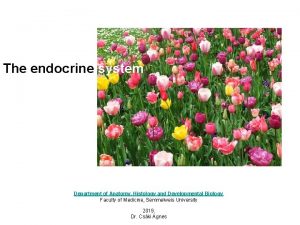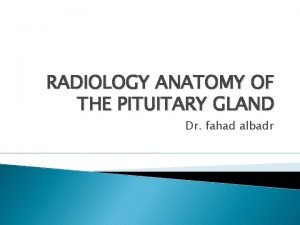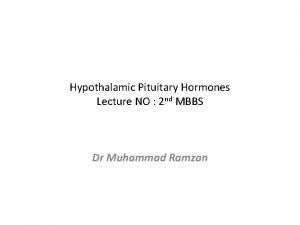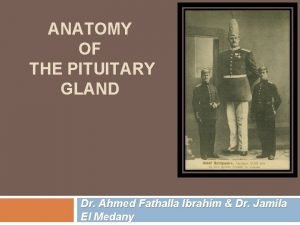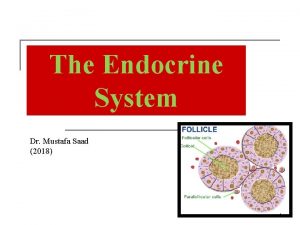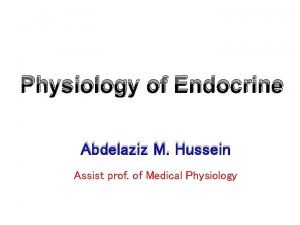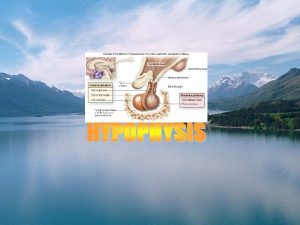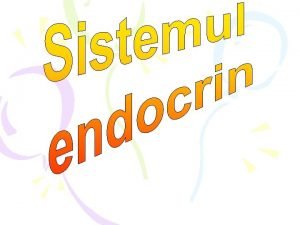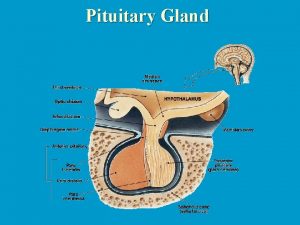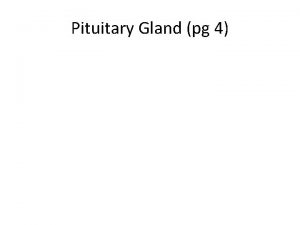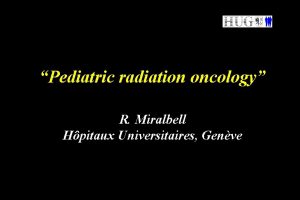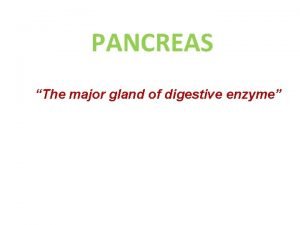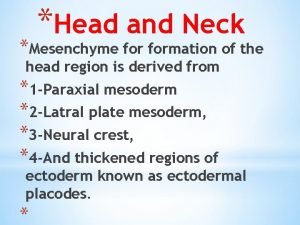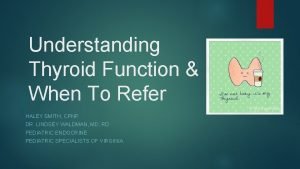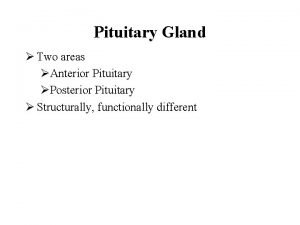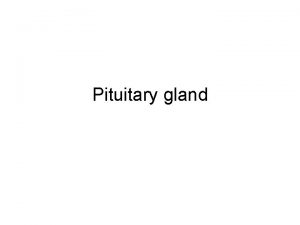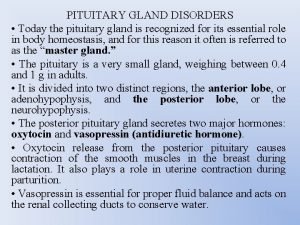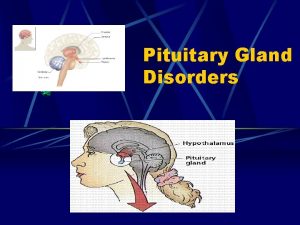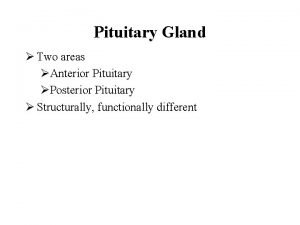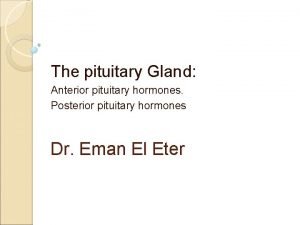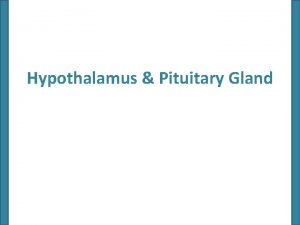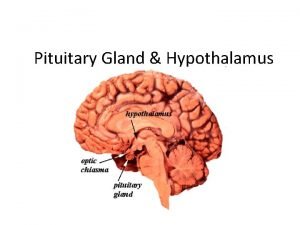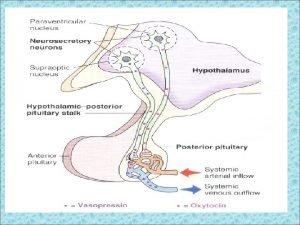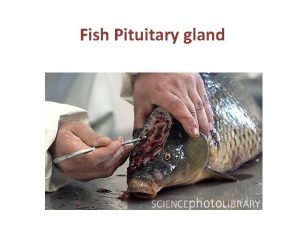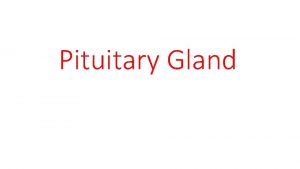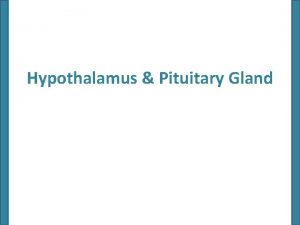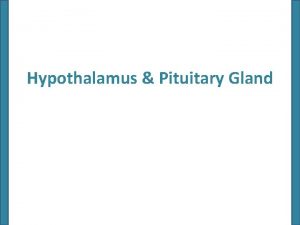Endocrine System The Pituitary Gland Known as the






















- Slides: 22

Endocrine System

The Pituitary Gland • • • Known as the “Master Gland”: it is the “checks and balances” system via the negative feedback mechanisms Located in the cerebrum Anterior lobe: glandular tissue; makes hormones – Tropic hormones: stimulate other endocrine glands to make their hormones; thyrotropic, adrenocorticotropic, and two gonadotropic hormones – Non. Tropic hormones: exert effects on non-endocrine targets; growth hormone and prolactin • Posterior lobe: nervous tissue; storage area for hormones made by hypothalamic neurons; oxytocin and antidiuretic hormone • Anterior: Stimulates the thyroid gland, Stimulates adrenal cortex, ACTH, GH Posterior: Causes contractions of the uterus, Regulates water balance •

The Pituitary Gland • The hypothalamus controls the pituitary gland – Anterior: a releasing factor that is produced in the hypothalamus and transmitted to the anterior lobe commands release of hormones to their target cells – Posterior: storage area for hormones made by hypothalamic neurons; oxytocin and antidiuretic hormone

Pituitary Hormones

Pituitary Hormones

Pineal Gland • Located in 3 rd ventricle or epithalamus of the brain • Secretes melatonin – inhibits reproductive system (especially in females) so adult body size is reached before sexual maturation occurs – Establishes biorhythms (sleep-wake cycles)

Thyroid Gland • Located at base of throat inferior to the Adam’s apple • Two lobes joined in the middle by the isthmus • Largest endocrine gland in the body • Works closely with the Islets of Langerhans in glucose metabolism

Thyroid Hormones • T 3 or triiodothyronine: increases oxygen consumption and metabolism of all cells; regulates energy levels • T 4 or thyroxine: regulates metabolism for the production of heat and energy in body tissue by controlling rate at which glucose is oxidized • Calcitonin or thyrocalcitonin: active in calcium metabolism, lowers calcium levels in the blood by inhibiting release of calcium from bone

Parathyroid Glands • Located on the posterior aspect of the thyroid • 2 parathyroids on each lobe of the thyroid totaling 4 parathyroid glands • Parathyroid hormone or parathormone: most important regulator of calcium ion homeostasis in the blood; causes increase in blood calcium levels which works in opposition to calcitonin

Thymus Gland • Located in the upper thorax just posterior to the sternum • Decreases in size as person ages • Thymosin: “incubator” for maturation of Tlymphocytes; partially controls immune system

Adrenal Glands • Located on the upper end of the kidney • Two parts: – Adrenal Cortex: outer part; produces steroid hormones collectively called corticosteriods – Adrenal Medulla: inner part; similar to post. Pituitary gland, made up of nervous tissue and releases hormones when stimulated by sympathetic nervous system called catecholamines

Adrenal Hormones • Adrenal Cortex Hormones – Mineralocorticoids: Aldosterone- regulates amount of Na and K+ in the body; which works in conjunction with ADH from the Post. Pituitary to maintain water or electrolyte balance – Glucocorticoids: Cortisolregulates metabolism of proteins, fats, and carbs – Gonadocorticoid: male androgen testosterone and progesterone – maintains secondary sex characteristics, supplements sex hormones secreted by glands

Adrenal Hormones • Adrenal Medulla Hormones – Epinephrine/adrenalin and norepinephrine: used in the alarm stage of the “flight or fight” response, increases heart rate, blood pressure, and blood glucose levels, dilates small passage ways of the lungs resulting in more oxygen and glucose in the blood and faster circulation of the blood to body organs

Pancreas- Islets of Langerhans • • • Located close to stomach in the abdominal cavity Both exocrine (has ducts) and endocrine (into the blood stream) Specifically the Islets of Langerhans are the endocrine tissue in the pancreas which produce hormones that are released directly into the bloodstream – Glucagon: increases blood glucose (hyperglycemic) – Insulin: decreases blood glucose, only hormone that is hypoglycemic, absolutely necessary is only way that glucose can get to cells to be used – How insulin works

Gonads • Male = testes(2) – Testosterone: develops and maintains male secondary sex characteristics • Female = ovaries(2) – Estrogen: controls menstrual cycle, prepares the uterus for implantation and pregnancy – Progesterone: develops and maintains female secondary sex characteristics

Negative Feedback • Definition: feedback that regulates the stimulus; a high concentration of a hormone in the blood has an inhibiting effect on its gland. • Hormone levels increase or decrease as the target organ requires; endocrine glands work together to maintain homeostasis.

Hyper- and Hypofunctions of Hormones Growth Hormone • Hyperfunction: – Gigantism (child) – Acromegaly (adult) • Hypofunction: – Dwarfism (child)

Hyper- and Hypofunctions of Hormones Thyroxine • Hyperfunction – Goiter: enlarged thyroid due to iodine deficiency – Grave’s Disease: hyperthyroidism resulting in eyes bulging anteriorly (exophthalmos)

Hyper- and Hypofunctions of Hormones • Thyroxine (cont. ) • Hyperfunction – Cretinism: occurs in children resulting in stunted growth – Myxedema: occurs in adults resulting in a decreased metabolism causing physical and mental sluggishness, obesity, chronic edema, poor muscle tone, and low body temperature

Hyper- and Hypofunctions of Hormones Insulin • Hyperfunction – Hypoglycemia: deficiency of sugar in blood • Hypofunction – Diabetes Mellitus: caused by deficient insulin release, leading inability of the body cells to use carbs at a normal rate. The three cardinal signs: 1) polyuria, 2) polydipsia, and 3) polyphagia

Hyper- and Hypofunctions of Hormones Steroids (adrenal cortex) • Hypofunction – Addison’s Disease: caused by deficient secretion of adrenal cortical hormones; characterized by bronze tone of the skin • Hyperfunction – Cushing’s Syndrome: caused by excess adrenocortical; characterized by increased weight gain and fat acculumation, osteoporosis, and a “moon shaped” face

Miscellaneous Facts about the Endocrine System • Endocrine glands are ductless and secrete hormones directly into the bloodstream. • Hormones are organic substance (chemical, steroid, or proteins) secreted by cells into the bloodstream that has an effect on metabolic activity of another cell (target organ); they are chemical messengers that help regulate cell activity • Hormones travel to all parts of the body but only affect their target cells • Hormones are excreted by the kidneys in urine
 Pituitary gland and pineal gland spiritual
Pituitary gland and pineal gland spiritual Thyoid gland
Thyoid gland Endocrine histology
Endocrine histology Nerve supply of pituitary gland
Nerve supply of pituitary gland Division of pituitary gland
Division of pituitary gland Nerve supply to pituitary gland
Nerve supply to pituitary gland Hypophyseal fossa and pituitary gland
Hypophyseal fossa and pituitary gland Hypophyseal fossa and pituitary gland
Hypophyseal fossa and pituitary gland Exocrine glands function
Exocrine glands function Hypophyseal fossa and pituitary gland
Hypophyseal fossa and pituitary gland Hypersecretion of prolactin
Hypersecretion of prolactin Posterior pituitary blood supply
Posterior pituitary blood supply Blood supply of pituitary gland
Blood supply of pituitary gland Prolactin hormones
Prolactin hormones Pituitary gland hormones
Pituitary gland hormones Pituitary gland
Pituitary gland Structure of posterior pituitary gland
Structure of posterior pituitary gland Pituitary gland
Pituitary gland Subdivision of pituitary gland
Subdivision of pituitary gland Hashitoxicosis
Hashitoxicosis Anterior pituitary
Anterior pituitary Pituitary gland embryonic origin
Pituitary gland embryonic origin Pituitary gland disorders
Pituitary gland disorders


